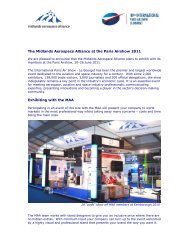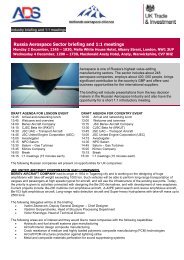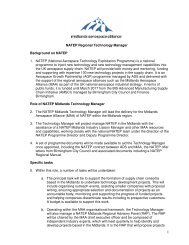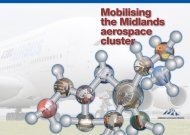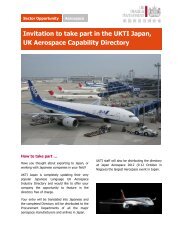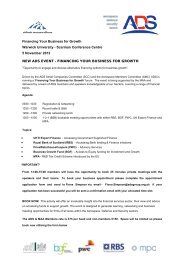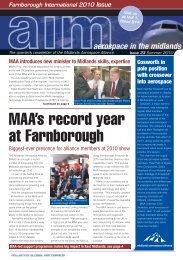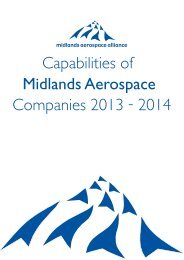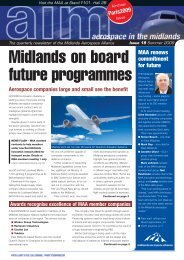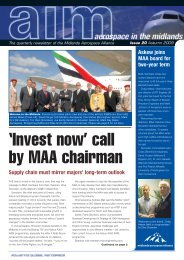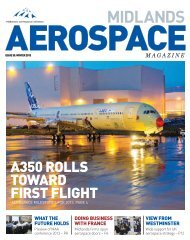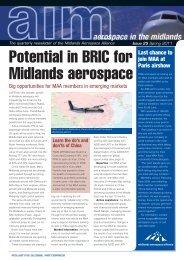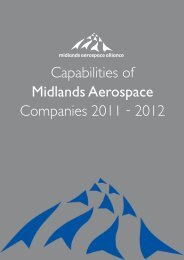new technology for aerospace
here - Midlands Aerospace Alliance
here - Midlands Aerospace Alliance
You also want an ePaper? Increase the reach of your titles
YUMPU automatically turns print PDFs into web optimized ePapers that Google loves.
Housing one of Rolls-Royce’s flagship University Technology Centres<br />
(UTCs) and the Systems Engineering Innovation Centre (SEIC – a<br />
partnership with BAE Systems and the East Midlands Development<br />
Agency), Loughborough University undertakes a wide range of <strong>aerospace</strong><br />
research and <strong>technology</strong> development.<br />
CASE STUDY: University Technology Centre in Combustion<br />
Aerodynamics<br />
The Loughborough Rolls-Royce UTC conducts a range of experimental<br />
and computational research to improve our understanding of the<br />
complex aerodynamic processes that govern the behaviour of gasturbine<br />
combustion systems and associated components. The UTC<br />
possesses unique test facilities, which allow fully-annular, enginerepresentative<br />
combustion systems to be studied. Smaller scale rigs<br />
are employed to explore the spatially- and temporally-resolved flow<br />
fields of system components. A range of instrumentation is used, from<br />
multi-hole pneumatic pressure probes to advanced non-intrusive optical<br />
techniques.<br />
Recently, increased emphasis has been placed on understanding the<br />
detailed unsteady fluid mechanics of combustion systems. Unsteady<br />
processes are critical to the occurrence of instabilities, and to the<br />
achievement of low emissions per<strong>for</strong>mance. This has increased the need<br />
<strong>for</strong> laser doppler anemometry (LDA) and particle image velocimetry (PIV)<br />
data, and 3D mapping of the turbulence field.<br />
To complement these experimental studies, computational fluid<br />
dynamics (CFD) is used to provide predictions of combustion system<br />
aerodynamics. Several recent projects have explored the potential of the<br />
large eddy simulation (LES) approach to provide insight into unsteady<br />
features of the flow, with notable improvements achieved compared to<br />
the more conventional statistical turbulence model CFD approach.<br />
The UTC receives research funding from Rolls-Royce, EPSRC, DTI,<br />
and the EU. The Centre has carried out studies on the combustion<br />
aerodynamics of the whole range of the Trent series of Rolls-Royce<br />
engines, including the latest Trent 900 <strong>for</strong> the Airbus A380. Work is just<br />
beginning at Loughborough on the Trent 1000 design selected <strong>for</strong> the<br />
Boeing 787 Dreamliner aircraft.<br />
Research in the Department of Aeronautical and Automotive<br />
Engineering is organized into 6 groups:<br />
Dynamics and control: The group develops advanced dynamics and<br />
control techniques and <strong>new</strong> methods <strong>for</strong> simulation, dynamic analysis<br />
and advanced control.<br />
Acoustics and vibration: The focus of this group is on the development of<br />
low-noise and low-vibration aircraft and automotive vehicles.<br />
Structures: The group’s research is aimed at improved methods to realise<br />
safe structural design, with a special emphasis on composite materials.<br />
Risk and reliability: This group works on the development of mathematical<br />
models to assess the reliability of engineering systems.<br />
Energy and combustion: Covering a range of activities, state of the art<br />
techniques are developed and applied to engineering applications such<br />
as fuel cells and novel fuel injectors <strong>for</strong> ic-engines.<br />
Applied aerodynamics: as well as hosting the Rolls-Royce UTC in Gas<br />
Turbine Combustion Aerodynamics this group undertakes experimental<br />
research (low speed wind-tunnel, high pressure nozzle testing) on<br />
vehicle, supersonic jet plume and damaged wing aerodynamics, and<br />
computational research into jet noise and Short Take Off Vertical<br />
Landing (STOVL) aircraft.<br />
Training: The department offers a number of relevant training courses and<br />
modules ranging from management to systems engineering and design.<br />
Modules can be trans<strong>for</strong>med into special training <strong>for</strong> companies.<br />
The Systems Engineering Innovation Centre (SEIC) was set up<br />
in 2003 as a partnership between Loughborough University, BAE<br />
Systems and the East Midlands Development Agency. The Centre offers<br />
research, training and consulting in all aspects of systems engineering,<br />
including requirements capture, risk analysis, systems architecture,<br />
rapid prototyping and lifecycle management amongst other product<br />
and service development activities. The SEIC is also leading the UK<br />
Aerospace Innovation Network (AIN) in Systems Engineering.<br />
Loughborough University also runs the Innovative Manufacturing<br />
and Construction Research Centre (IMCRC). Together with industry<br />
partners such as Alstom, BAE Systems, Goodrich and Rolls-Royce,<br />
the group undertakes research covering <strong>new</strong> <strong>technology</strong>, business,<br />
organisational per<strong>for</strong>mance and human factors.<br />
Contacts:<br />
Ken Astley<br />
Business Development<br />
k.r.astley@lboro.ac.uk<br />
01509 635208<br />
Dr Ayman El-Fatatry<br />
SEIC<br />
01509 63 5203<br />
a.el-fatatry@lboro.ac.uk<br />
Links:<br />
Department of Aeronautical and Automotive Engineering<br />
www.lboro.ac.uk/departments/tt<br />
SEIC<br />
www.seic-loughborough.com<br />
IMCRC<br />
14 www.lboro.ac.uk/departments/eng/research/imcrc<br />
15



